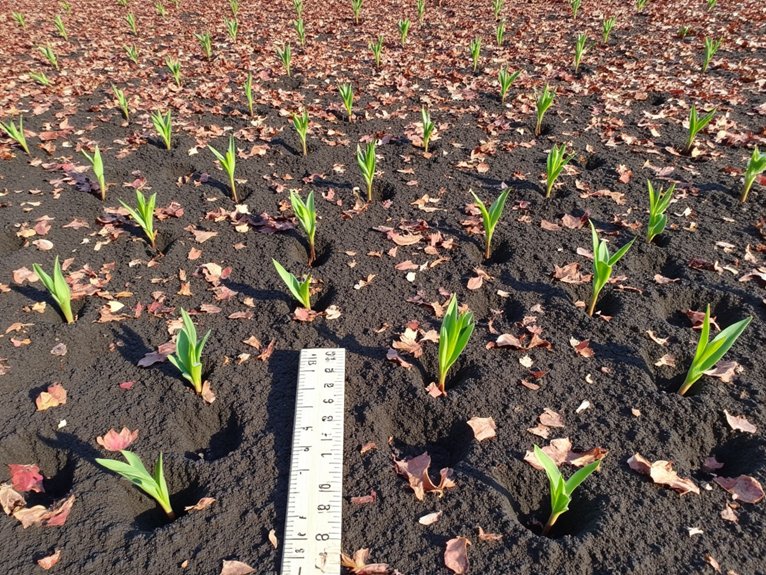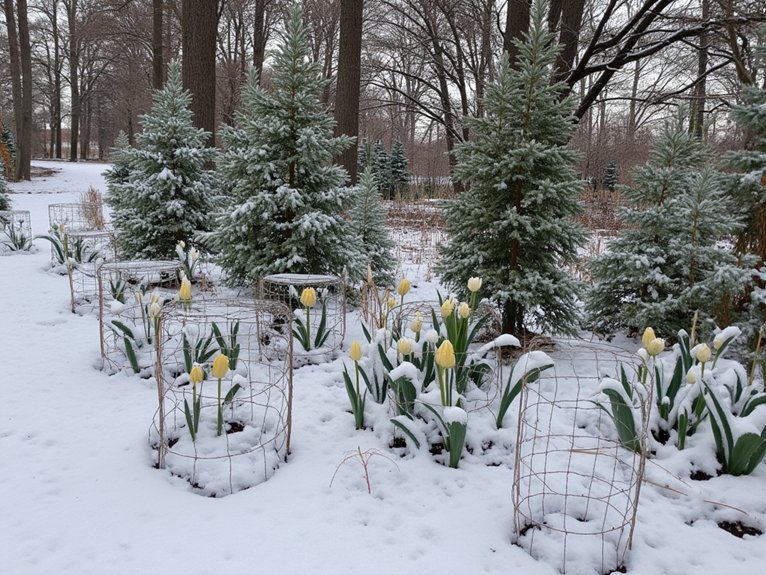You’ll discover that planting tulips in fall isn’t just tradition – it’s science-backed timing that guarantees stunning spring blooms. As Master Gardener Jane Smith explains, “The cool soil temperatures and consistent moisture of autumn create ideal conditions for root development.” Your success depends on several critical factors, from selecting firm bulbs to precise planting depths, and there’s a specific window of opportunity you won’t want to miss.
Contents
Timing Your Tulip Planting for Success

When it comes to planting tulips, timing is everything for achieving those stunning spring blooms you’re dreaming about. Your planting calendar should target late fall when soil temperatures consistently stay below 60 degrees.
To maximize success, check your climate considerations carefully. You’ll want to plant after the heat waves have passed but before the ground freezes solid – typically late October through November in most regions. Remember, your bulbs need about 14 weeks of dormancy to develop properly.
Don’t worry if you’re running a bit late – you can still plant until January if your soil remains workable, though earlier planting yields better results.
Selecting and Storing Quality Bulbs
Success with tulips starts at the source – selecting top-quality bulbs from reputable growers and suppliers. When choosing bulbs, they should feel firm and heavy for their size, without soft spots or visible damage.
For best quality assurance, inspect each bulb carefully:
- Look for dense, intact outer layers
- Choose bulbs free of mold or discoloration
- Select larger bulbs within your chosen varieties
Store bulbs in a cool, dry place below 60°F until planting time. If you’re buying multiple bulb varieties, label them clearly and keep them separated. A paper bag or mesh container works perfectly for storage, allowing proper air circulation while preventing moisture buildup.
Preparing the Perfect Soil Environment

The right soil preparation sets your tulip bulbs up for years of beautiful blooms. Start by testing your soil’s pH – you’ll want it between 6 and 7 for ideal growth. Work in soil amendments like compost or peat moss to a depth of 12 inches, ensuring proper drainage improvement.
“Tulips can’t tolerate wet feet,” says master gardener Joan Smith. “Create berms in low spots to prevent water pooling.”
For heavy clay soil, mix in coarse sand to increase drainage. If you’ve got sandy soil, add organic matter to help retain moisture. Keep the soil workable but not muddy when planting.
Strategic Planting Techniques and Spacing
Proper spacing and planting depth make all the difference in creating stunning tulip displays that return year after year. When designing your planting patterns, space bulbs 4-6 inches apart in clusters of 5-7 for maximum impact.
Dig holes 5-6 inches deep, adjusting slightly based on your soil type. “In sandy soil, plant an inch deeper; in clay soil, go slightly shallower,” advises Master Gardener Jane Smith. Place bulbs with their flat ends down and pointed tips up, following natural spacing strategies like triangular or diamond patterns.
For mass plantings, excavate a wide area to your target depth, arrange bulbs, then backfill systematically.
Winter Protection and Early Spring Care

Once winter’s chill sets in, protecting your tulip bulbs becomes essential for ensuring vibrant spring blooms. Apply a three-inch layer of winter mulch like straw, leaves, or hardwood chips to prevent temperature fluctuations and early sprouting.
When spring arrives, carefully remove the mulch to allow soil warming. You’ll want to begin spring watering once shoots emerge, keeping soil moist but never waterlogged. Monitor for any pest damage or disease, and add a balanced fertilizer as growth begins.
“Proper winter protection followed by attentive spring care will reward you with stunning blooms,” says Master Gardener Jane Smith. “Just remember to remove spent flowers to maintain bulb health.”
